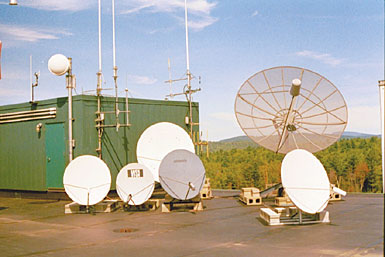Vital Signs
Web conferencing: The newest wrinkle in distance learning
Imagine a miniature classroom that could fit right on your desk. Now imagine attending a conference in that little classroom whenever it was most convenient for you.
Such a feat is already possible— via computer. Dartmouth- Hitchcock Medical Center recently began offering medical conferences, lectures, and other health information over the World Wide Web. Now, healthcare providers, students, and even patients are able to view conferences on any computer— either live, as they are happening, or later, at a more convenient time.

|
|
This array of satellite dishes on the roof of DHMC was once key to the institution's long-distance conference capabilities— but now professional meetings and even patient lectures are offered via the Web and thus are available on any computer. |
Pioneer: DHMC pioneered a related technology—videoconferencing— in 1968 with the launch of INTERACT, an interactive television system. The network, which relied on landbased microwave transmitters to provide communications, grew from linking DHMC with Claremont General Hospital (now Valley Regional Hospital) for psychiatric consultations, to linking seven New Hampshire and Vermont hospitals. INTERACT was the first system in the nation to connect an academic medical center with primarycare physicians.
In the 1980s, DHMC was in the process of developing a satellite- based network that could theoretically have connected as many as 50 hospitals if they subscribed to the system. But funding shortages kept that concept from reaching its full potential.
More recently, DHMC has had a videoconferencing system using microwave or dial-up communications that can link from two to seven sites. It is used for administrative meetings, distance learning, and grand rounds presentations. But videoconferencing requires a television monitor and videoconferencing equipment at both ends—the site where the educational session or meeting is taking place and any site(s) where other participants are located.
But the newest technology— Web-based conferencing—requires only that the conference site be able to transmit the program. Participants need nothing more than a computer on which to receive it.
Such a system is especially convenient for patients who need to attend educational sessions but live some distance from DHMC. For example, obese patients who are prospective candidates for gastric bypass surgery are required to attend three lectures before they are eligible to even be considered for the procedure. Previously, such patients had to drive to DHMC in Lebanon, which for some can be quite a distance, to attend the lectures. With the new Webbased system, however, patients are able to view the lectures at home.
Medical staff can attend conferences via the Web, too. The cost of doing a Web conference is a fraction of the cost of traditional videoconferencing, according to Ray Kulig, the coordinator of DHMC's videoconference services. A six-hour conference, for instance, might cost a hospital several hundred dollars to receive via traditional videoconferencing, but watching the conference through a Web connection on an LCD projector costs nothing.
Option: There are still more advantages to a Web conference. Questions can be e-mailed to conference speakers and documents can be downloaded before or during a conference. A Web production can originate as easily in a private office as in a large auditorium. And viewers have the option of watching the conference live or later.
DHMC is one of the first hospitals in the nation to use Webconferencing technology for patient education, says Kulig. More information on DHMC's Webconferencing services is available at www.dhvideoconferences.org.
Laura Stephenson Carter
